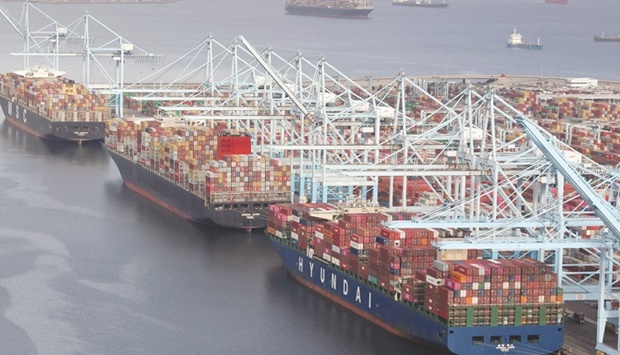One of the main goals that US President Joe Biden has set for his administration is to empower American workers and the country’s middle class. Many believe that globalisation (along with several other factors) contributed to stagnating real wages, rising inequality, and the sense that American workers have lost out to workers in other countries with lower labour standards. But in its attempt to reverse these trends, the Biden administration has embraced protectionist rhetoric and policies that will cause American workers to lose once again.
Though any mention of the word “openness” is met with suspicion nowadays, the surge in inflation – the US Consumer Price Index was up 8.3% in April – has nonetheless prompted a discussion among economists about whether trade liberalisation (and openness more generally) could be used to rein in rising prices. Since one of the main arguments for free trade is that it lowers prices for consumers, the link between open borders and inflation is worth contemplating.
To be clear, no reasonable economist claims that the recent inflation is the result of trade restrictions. By now, the causes are well understood to be a combination of pandemic-driven supply-side shortages, policy-fuelled demand, and further supply-side disruptions caused by Russia’s war in Ukraine. But as policymakers struggle to contain inflation without causing a recession, they must recognise that “Buy American” requirements, tariffs, and immigration restrictions may be making a bad situation worse.
According to a recent Peterson Institute for International Economics (PIIE) policy brief, a feasible reduction of trade barriers “could deliver a one-time reduction in [CPI] inflation of around 1.3 percentage points.” The study is conservative, focusing only on trade restrictions that can plausibly be lifted in the short term, and its authors are careful to emphasise that the result would be a one-time outcome. The proposed reduction of trade barriers would not solve the problem of rising prices; but it would make today’s high prices lower.
US consumers would welcome such short-term relief. If the Biden administration finds it necessary to sell oil out of the Strategic Petroleum Reserve despite its commitment to addressing climate change, why shouldn’t it also recognise the need to reverse Donald Trump’s tariffs? In 2021, according to the PIIE brief, these duties still applied to more than half of US imports “subject to high tariffs, penalty duties, or severe quotas.”
Perhaps more importantly, openness, whether it is free trade or immigration, also contributes to consumer welfare in indirect ways. Though these effects are often hard to quantify, they are of first-order importance, which is why economists often turn to first principles when debating them.
One of the most important benefits of free trade is that it exposes domestic firms (and labour markets) to greater competition, which induces them to keep prices low and to innovate constantly to stay ahead of the curve. Similarly, immigration eases labour-supply shortages, and high-skilled newcomers can boost productivity and innovation. Forward-looking countries understand this and embrace immigration. The United Kingdom, for example, has adopted a new skilled-worker visa program that welcomes graduates of top global universities.
It is deeply misguided to restrict trade and immigration at a time when rising domestic prices are of paramount concern. Now that everyone is fixated on inflation, it is worth considering why inflation was so low these past two decades, despite full employment in the United States (prior to the pandemic) and despite ultra-expansionary monetary policies. Globalisation (now a loaded term) arguably had a lot to do with it, as did automation (another loaded term).
The prospect of outsourcing jobs to lower-wage countries or to machines constrained workers’ bargaining power. At the same time, foreign competition constrained domestic firms’ pricing power (though there is ample evidence that the cost reductions they achieved by globalising production still allowed them to make hefty profits).
Workers and firms face a different reality today. Their jobs and businesses seem more secure now that the US has turned inward and embraced protectionism. The “Great Resignation” and other developments have reduced the supply of workers, increasing the bargaining power of those still in the labour force.
This could be a positive development, except that the high inflation rate has undermined efforts to make the average American worker better off. While nominal wages in the US rose by 5.6% in the year ending in March (more than an extrapolation of the earlier trend would have implied), that month’s 8.5% inflation rate implied that real wages fell by 2.7%.
If there is any silver lining to today’s inflation, it lies in the lessons that this episode has provided to policymakers and the public alike. Because the benefits of open borders (lower prices) are less salient than the costs (lost jobs or lower wages), and because consumer interests are not organised, while worker interests often are, there is a bias toward protectionist sentiment. Today’s inflation highlights the need to resist this bias.
The current decline in real wages is a reminder that our well-being depends not only on the nominal wages we earn as workers but also on the prices we pay as consumers. Open borders can help keep prices low during a challenging time. Reversing the tariffs imposed by the Trump administration would be a step in the right direction. – Project Syndicate
• Pinelopi Koujianou Goldberg, a former World Bank Group chief economist and editor-in-chief of the American Economic Review, is Professor of Economics at Yale University.

Seaport, Cargoshjip, Containers, Port


